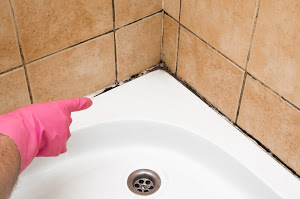Mold needs moisture and humidity to grow. You’ll often see it in bathrooms around the shower, bathtub, or sink. Mold lurks on window frames, in laundry rooms, and even inside the washing machine. You’ll be surprised at how many places in your home mold will hide.
Mold is more than unsightly; it also poses a health risk. So, how do you kill mold?
Does Bleach Kill Mold?
 Bleach is often marketed as a solution to kill mold, but it doesn’t work. It merely bleaches out the color (the melanin mold produces) so you think the mold is gone.
Bleach is often marketed as a solution to kill mold, but it doesn’t work. It merely bleaches out the color (the melanin mold produces) so you think the mold is gone.
In a matter of weeks, the fungi produce more melanin, the color returns, and the very same patch of mold you thought you’d removed is visible again.
Bleach may help remove surface mold on non-porous materials like tiles and sinks. But there are better solutions below.
It won’t kill mold on porous surfaces such as wood furniture, drywall, fabric, carpeting, or paper. Because the roots of these fungi attach themselves deeper into the material. It’s a little like cutting down a weed. It will eventually grow back if you don’t remove the roots.
How to Kill Mold Without Bleach
ATH recommends natural mold killers for non-porous surfaces including hard plastic, porcelain, ceramic, and stainless steel. They are better for the environment, more effective, and safer than working with bleach.
Vinegar to Kill Mold
- Pour a mixture of 80% vinegar and 20% water into three buckets.
- Dip a microfiber cloth into the first bucket.
- Clean a patch of mold.
- Rinse the cloth in the second bucket, and again in the third.
- Repeat this process until you’ve removed the mold.
- Finally, wipe the surface down with a dry microfiber cloth.
Kill Mold with Baking Soda
- Dissolve two tablespoons of Bicarbonate of Soda into water.
- Spray the mixture on to the mold.
- Let the solution sit for 5 to 10 minutes, then scrub and wipe the area with a damp cloth.
- Wipe the area dry with a clean microfiber cloth.
Tea Tree Oil to Kill Mold
- Add two teaspoons of tea tree oil to a spray bottle filled with water.
- Spray the mold, but do not rinse.
- Wipe the areas dry with a clean microfiber cloth.
Grapefruit Seed Extract Mold Killer
- Fill a spray bottle with water.
- Add 20 drops of grapefruit seed extract.
- Spray on the affected area and do not rinse.
- Wipe the area dry with a clean microfiber cloth.
How Do I Kill Large Areas of Mold on Porous Surfaces?
 Do not attempt to clean the mold until you get a professional recommendation.
Do not attempt to clean the mold until you get a professional recommendation.
The problem is mold spores. They are invisible to the naked eye and travel through the air when disturbed (including cleaning activities, HVAC operation, or even opening and closing doors).
Mold spores land on other surfaces inside your home and start new colonies.
Mold often causes permanent damage to porous materials. Depending on the extent of the damage and a few other variables, we may be able to restore personal belongings through a contents packout service.
Our specialized cleaning methods include drying chambers, ultrasonic washing, spray and wipe, immersion cleaning, ozone treatment, air duct washing, and deodorization.
But drywall and flooring, for example, may need replacement. In that case, mold remediation is essential.
Mold Prevention Tips
Your best solution is to avoid mold growth in the first place. Review our 17 mold prevention tips and browse mold problem FAQs.
If you need help to kill mold in sizeable areas of your home, please contact us today. The first step is a free consultation by our certified mold inspector.
Next, we may recommend laboratory mold testing to determine the species of mold, (for instance black mold) the toxins it’s producing, and if the spores are airborne.
We can then answer any questions or provide an estimate for mold remediation services. Take a look at our customer reviews and blog.
